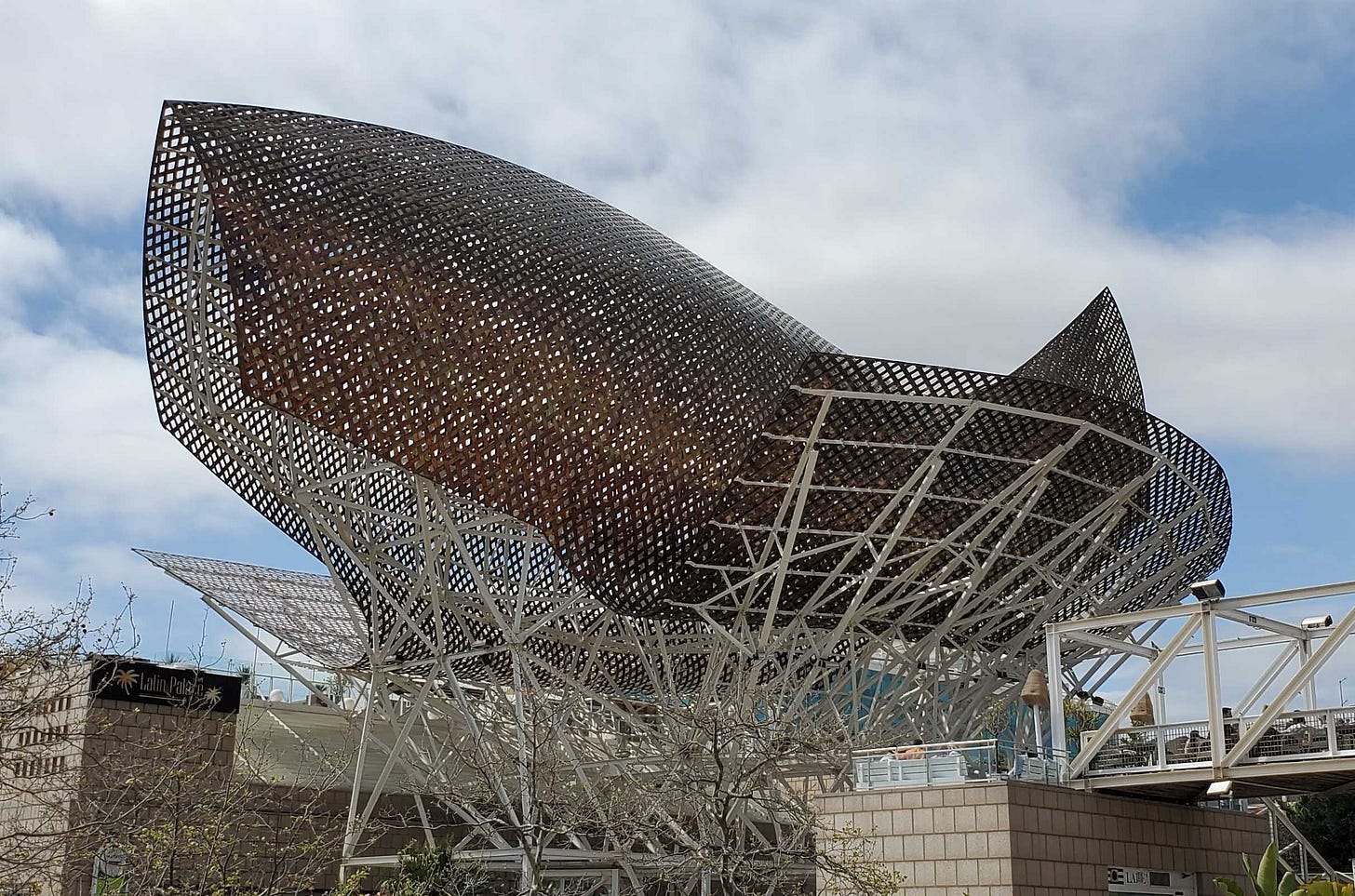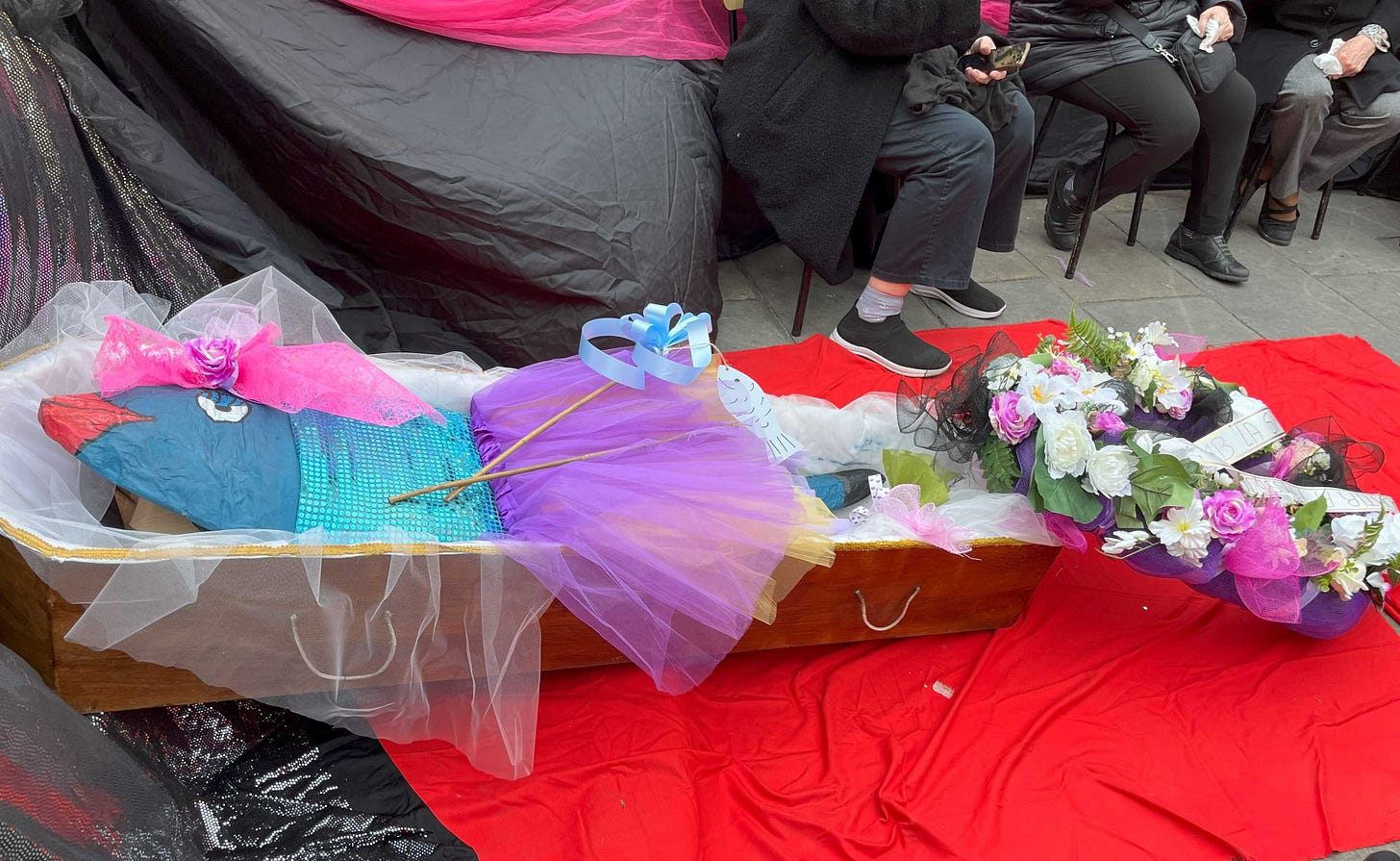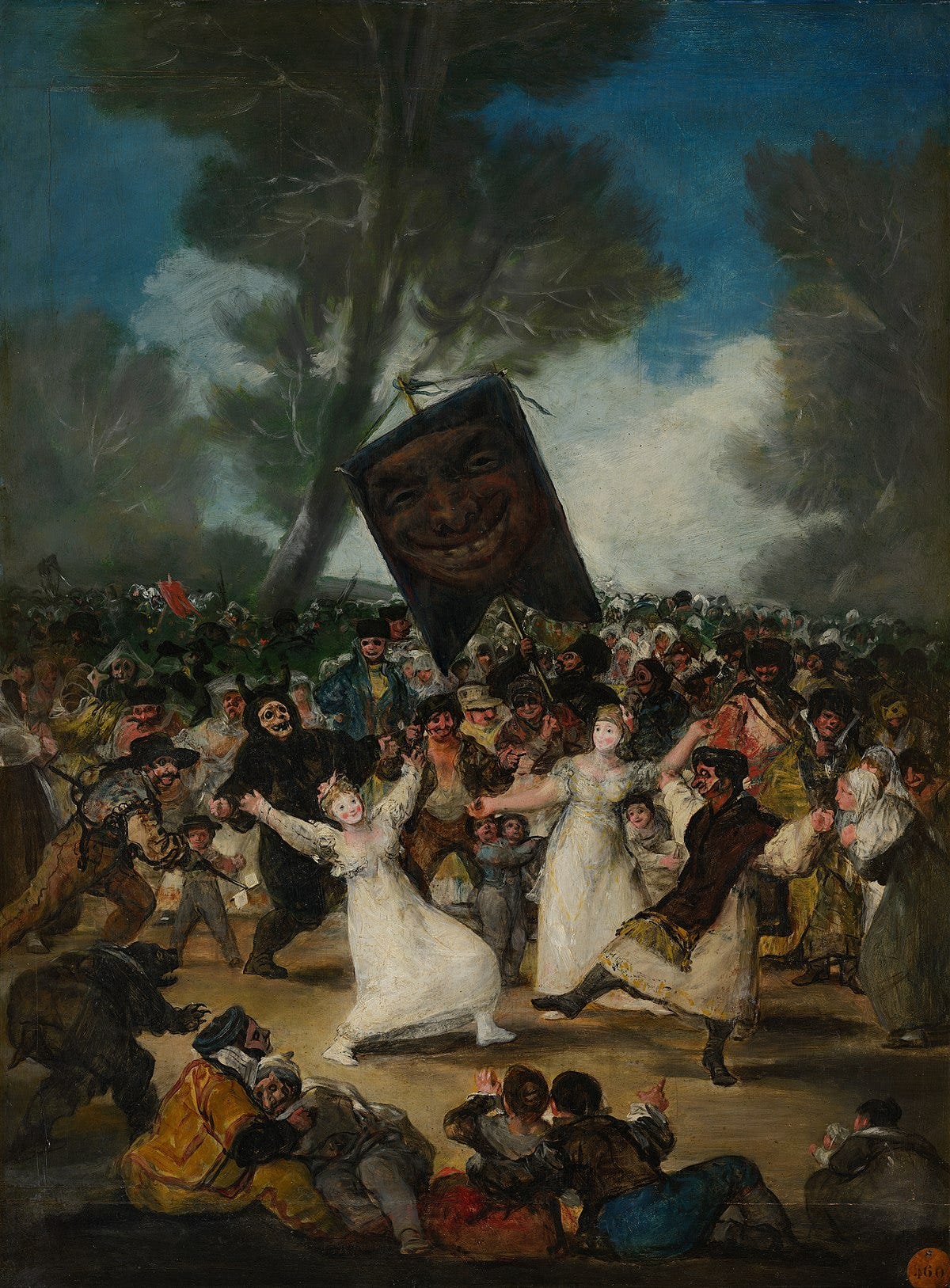Entierro de la Sardina (Burial of the Sardine)
How a Seemingly Lowly Fish Earns A Place of Honor
Early last week, I had my first dental appointment in Spain. I was a bit nervous since I had some sensitivity in one of my teeth. The tooth was the one in which my dentist in Arizona had replaced the crown. He advised me that at some point, I might need a root canal performed on that tooth. I dreaded that prospect, but he assured me that if I needed dental care in Spain, the country is ranked among the world’s best. Regardless, whether a country has the best or the worst dental care, root canal was not on my bingo card for this year.
Our friend, Jean-François recommended his dentist in Barceloneta. After visiting the dentist, in Barceloneta, I was pleasantly surprised that he did not see the need for root canal. He told me my teeth looked good and that I should return for a cleaning in October. That was a relief. Plus the visit cost only 35 € (and filling out only one double-sided form to boot). To celebrate, Les and I decided to visit a restaurant we hadn’t been to since our first visit to Barceloneta in February, a neighborhood that we don’t get the opportunity to explore very often. Our gym is located on the edge of the neighborhood, next to Frank Gehry’s “Golden Fish.” After the gym, we usually head home or to another part of town. This time we decided to return to a restaurant that we enjoyed on our first foray into the area.
El Peix d’Or (The Golden Fish) by Frank Gehry
The Barceloneta neighborhood of Barcelona is located on what is best described as a “spit” of land that juts out into the Mediterranean from the city proper. It was constructed in the 18th century to settle residents of portions of the La Ribera neighborhood who were removed to make way for the construction of the old citadel (which has since become Parc de la Ciutadella). The neighborhood is laid out in a grid pattern of narrow streets and houses that would not look out of place in an East Coast American port city such as Philadelphia or Baltimore.
Yet, the neighborhood is often overlooked, known primarily as the disembarkation point for cruise ship passengers and its public beaches. As with most of Barcelona, there are rich cultural traditions, celebrated here and in other parts of the country. On a chilly February afternoon earlier this year, we experienced a spectacle that while mostly unique to Spain, had its own Barceloneta character.
The Sardine, Lying in Repose
That day, as we made our way along the Carrer de Sant Miquel, people were beginning to assemble around the church entrance. Onlookers in the crowd strained to not only get a glimpse but to take photos of the star attraction for the impending ritual. “Who is this,” I wondered. My curiosity brought me closer to the circle of professional mourners, a few quietly sobbing. Once I reached the center of the observance, I gazed upon the dearly departed. It was a stuffed fish figurine, dressed in taffeta, lying in a casket adorned with flowers. It was the ceremonial sardine, adorned and ready for her beachside burial. This was my introduction to the Entierro de la Sardina or Burial of the Sardine festival.
With the end of the Franco era, public festivals and cultural events have “exploded” throughout the country1. This was especially true in Catalonia. The suppression of Catalan political and cultural identity during Franco’s dictatorship meant that many events, including religious celebrations, were more subdued2. Some of these celebrations have also been promoted in guidebooks and websites geared towards tourists. Yet, I discovered an age-old festival that has its roots in the Catholic Church but might have easily been mistaken as a secular celebration.
Unbeknownst to us, the pre-Lenten season of Carnaval is celebrated in Barcelona as it is in many other locations around the world that have roots in the Mediterranean. Although not as vibrant as Venice, Rio de Janeiro, or New Orleans, it is nonetheless a time for fiestas but with little of the debauchery that accompanies other celebrations. In other words, I didn’t see any gratuitous nudity or vomiting in the streets. Generally people have costume parties, much like at Halloween. There is one particular Ash Wednesday ritual that seems to be typically Spanish: the “Entierro de la Sardina” or the Burial of the Sardine.
“Why the sardine,” one might ask. For me, and maybe for many Americans, sardines seem to have had a checkered history. My first experiences were the canned variety that I consumed on rare occasions. As a family, we’d pack them for picnic lunches on trips to the Jersey Shore. I didn’t care for them at first since I associated them with the stench of the cooler after sitting in the hot sun at the beach for an entire day. It wasn’t until I enjoyed fresh sardines as an adult that I appreciated sardines as both a freshly cooked fish and even the canned variety. In recent years, there appears to be a foodie craze for tinned fish, if it still is indeed a thing. Restaurants now offer canned fish as appetizer or charcuterie board selections for prices north of $20 all for an item anyone can buy at a local supermarket for less than five dollars. Yes, we might have reached peak tinned fish in the US.
This brings us to the Sardine Burial ceremony. According to the Spanish Tourism website, this is a ceremony that is celebrated predominantly in Murcia, culminating in a lavish festival at the end of Easter Week3. Approximately thirty groups of “sardineros” entertain the crowds. This culminates in a parade featuring floats and the “cabecera” with “giants and big heads”4. In other parts of Spain, including Barcelona, it is a culmination of the Carnaval festival. As for its origins, our school tour guide stated that it began during a time of famine when meat was scarce, but sardines were readily available. In order to preserve them, they were coated with salt and buried until such time as they were ready to be eaten5. The celebrations themselves symbolize the transition between the season of Lent, a time of abstinence and fasting, and times of more permissiveness and indulgence6. It’s also the subject of a Goya painting housed in the Real Academia de Bellas Artes de San Fernando (Royal Academy of Fine Arts of San Fernando) in Madrid.
Goya, Francisco. Entierro de la Sardina. c. 1812-1819, Real Academia de Bellas Artes de San Fernando, Madrid.
It is the above painting that Josipovici refers to in his discussion although he finds the celebration “grotesque,” especially in light of most Americans’ familiarity with canned sardines7. Arrabal remembers the festivities in the Spanish village of his childhood not as a joyous celebration, but as a “revolt against the moral order” imposed by the Catholic Church8.
The burial service that we all attended that day was neither grotesque nor revolutionary. Nor was it as lavish as the festivities that characterize the one in Murcia. It had an air of familiarity but not exclusivity. The atmosphere was rather welcoming. We all gathered in the plaza fronting the Església de Sant Miquel del Port (Church of Saint Michael of the Harbor). It was less somber than I expected although there were the professional mourners who played their parts admirably.
Mourning the Dearly Departed Fish
After the solemn service, we then partook of bread, sardines, and wine offered by the good parishioners. A second glass of wine and we were then ready to process to the beach. This was the Barceloneta aspect that shone through, the focus on the sea. Along the way, we carried cut-out paper sardines on a stick. After the burial of the sardine effigy we then buried our paper sardines. We hoped that by doing so we’d have luck throughout the year. Still hungry and craving more sardines (I wonder why), Les and I headed out to find a spot for dinner. As usually happens, we stumbled upon a local restaurant that might become a usual stop whenever we’re in Barceloneta. And guess what, it has! The restaurant had excellent dishes and about a dozen craft beers on tap. It was a totally unexpected find at the time. It did not disappoint the second time around.
Yummy Sardines for Dinner
As I look back on the Burial of the Sardine festival, I realized it was only the start of our fourth month in Barcelona. I realized then, as now, that these types of events are small but meaningful ways to connect with our new home. I can’t emphasize the importance of getting out and taking every opportunity to absorb all that you can in any unfamiliar environment. It’s making our move seem worth it more every day. For a new resident or even a tourist, veering off the well-trodden main streets and checking out a side street or alley might yield an interesting discovery that could prove inspirational. You never know who you’ll meet or what you’ll find (and no dentist appointment is needed).
Note: I have decided that I will be posting my essays approximately every other week rather than weekly. I hope you all don’t mind but if the spirit moves me to write something sooner, I certainly will. Salud!
Works Cited
1,2Richards, Greg. “Culture and Authenticity in a Traditional Event: The Views of Producers, Residents, and Visitors in Barcelona.” Event Management: An International Journal, vol. 11, no. 1–2, 2007, pp. 33–44, https://doi.org/10.4324/9781315578781-11.
3,4“Entierro de la Sardina.” España: Portal oficial de turismo de España, Entierro de la Sardina. 06/04/2024. Fiestas en Murcia | spain.info.
5Cejudo-Gumiel, Beatriz. “Walking Tour: Barceloneta.” Sponsored by World Class Barcelona language school, 14 February 2024, Barcelona, Spain.
6Entierro de la Sardina. https://entierrodelasardina.com/
7Josipovici, Gabriel. “The Burial of the Sardine.” Raritan, vol. 40, no. 2, Fall 2020, pp. 85–89. EBSCOhost, https://search.lib.asu.edu/permalink/01ASU_INST/fdcm53/cdi_proquest_journals_2486197319.
8Arrabal, Fernando, et al. “Most Unusual Performances.” The Drama Review: TDR, vol. 22, no. 2, 1978, pp. 75–96, https://doi.org/10.2307/1145203.









Was the restaurant "Estraperlo" by any chance?? That's my go to spot here in Barceloneta, we'll have to meet there for a bravas one day!